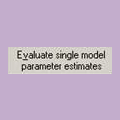|
||||||||||||||||||||||||||||||||||||||||||||||||||||||||||||||||||||||||||||||||||||||||||||||||||||||||||||||||||||||||
|
||||||||||||||||||||||||||||||||||||||||||||||||||||||||||||||||||||||||||||||||||||||||||||||||||||||||||||||||||||||||
| Calculating Bayesian posterior distributions |
|
|||||||||||||||||||||||||||||||||||||||||||||||||||||||||||||||||||||||||||||||||||||||||||||||||||||||||||||||||||||||
|
An opportunity is offered to calculate Bayesian posterior distributions for specified parameters. Posterior distributions are created by numerically integrating, in user chosen increments, across multidimensional parameter space, the posterior probabilities for values of the specified parameter of interest. This procedure can be extremely time consuming, but some mitigation is achieved by giving the analyst the opportunity to choose the increment size (or equivalently the grid resolution) for numerical integration. Nevertheless, although SmartStats © can integrate up to six (6) additional parameters into the calculation of the posterior distribution, only one (1) or two (2) dimensional integrations are recommended. Smartstats© will guide you through the procedures to generate the posterior distributions for a chosen parameter, but note that this procedure requires carefully preparation of the parameter space prior to executing the calculation of the posterior distributions. The covariance matrix for the current model fit can be an excellent guide for choosing the relevant parameter space, particularly for unconstrained parameter space, in that an analyst can use information from the most probable point estimates and the covariance matrix to propose reasonable domains for the parameter space. However, the covariance matrix is naïve about the parameter space, thus user modification of the parameter space may be required if, for example, the parameter’s domain is restricted to between zero (0) and one (1) as in a survival rate. The need for such a user intervention in this case follows from SmartStats © initial naïve presumption of a Gaussian (normal) form for the posterior distribution such that a large enough standard error would propose values less than zero (<0) or greater than one (>1) to be within the parameter space for a survival rate. One dimensional plots of the posterior distribution of the parameter of interest will be generated by SmartStats ©, however, if only one other parameter is integrated into the posterior distribution, a bivariate contour plot of the joint posterior distribution is offered as well. The numerical output of the procedure to calculate Bayesian posterior distributions can be saved in a text file. Hopefully, sometime in the not too distant future the use of a Markov Chain Monte Carlo (MCMC) algorithm to calculate posterior distributions will be implemented in SmartStats ©.
|
||||||||||||||||||||||||||||||||||||||||||||||||||||||||||||||||||||||||||||||||||||||||||||||||||||||||||||||||||||||||
